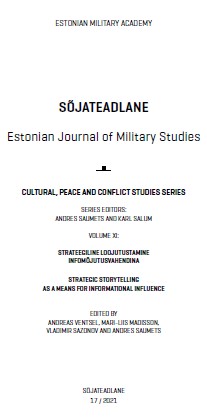COVID-19-TEEMALISTE VANDENÕUDE JA VANDENÕUTEOORIATE KUJUTAMISEST STRATEEGILISTES NARRATIIVIDES: RT JA SPUTNIKU LUGUDE SEMIOOTILINE ANALÜÜS
A PROJECTION OF CONSPIRACIES AND CONSPIRACY THEORIES ABOUT COVID-19 IN STRATEGIC NARRATIVES: A SEMIOTIC ANALYSIS OF THE CONTENT OF RT AND SPUTNIK
Author(s): Mari-Liis Madisson, Andreas VentselSubject(s): Media studies, Politics and communication, Health and medicine and law
Published by: Kaitseväe Akadeemia (KVA)
Keywords: conspiracy theories; semiotic approach of strategic narratives; RT and Sputnik mediaanalysis;
Summary/Abstract: In spring of 2020, a study was published on conspiracies/conspiracy theories regarding the projection of the coronavirus in Russian state-financed Anglophone media outlets RT and Sputnik. In our analysis, we outlined five major motifs regarding the narration of conspiracies and conspiracy theories in RT and Sputnik. Russian outlets generally express explicitly negative attitudes towards conspiracy theories. However, we detected two peculiarities of strategic narration in such representations: (a) criticism towards conspiracy theories and (b) conspiracy-based explanation of the circulation of conspiracy theories. We identified three motifs regarding the criticism on conspiracy theories. First, the viral dissemination of conspiracy theories that blame 5G for the rapid spreading of COVID-19 was fiercely condemned in RT and Sputnik for being an expression of irrational fear and weakness of the Western people. The growing popularity of anti-vaccine conspiracy theories was denounced in a similar, sometimes even ridiculing manner. Conspiracy theories that refer to the coronavirus as a bioweapon were treated as a particularly dangerous form of COVID-19 infodemic and the USA leaders were severely condemned for spreading them. These three motifs enabled RT and Sputnik to position themselves as media-literate and critical channels. In relation with these three motifs, we distinguished two dominant ways in which RT and Sputnik are using a strategic depiction of conspiracy theories. Firstly, an anti-conspiracy discourse was used to support the strategic narrative of the Russian Federation in their general resentfulness towards the West, i.e. a story about a morally corrupt elite and frightened, easily manipulative people. Such a narrative enables to strengthen the anti-Western attitudes and present the Russian Federation and the people who consume Russian media as insightful and moral agents. Secondly, the Russian Anglophone media outlets presented selective criticism on conspiracy theories. The USA, EU, and the Western mainstream media were blamed for voicing and circulating COVID-19 plots.
Journal: Sõjateadlane
- Issue Year: 2021
- Issue No: 17
- Page Range: 119-158
- Page Count: 40
- Language: Estonian

